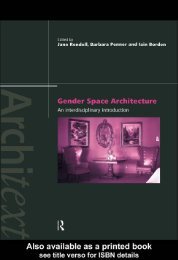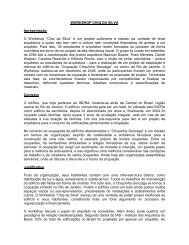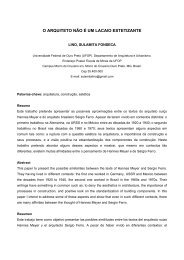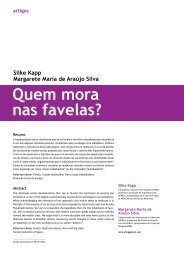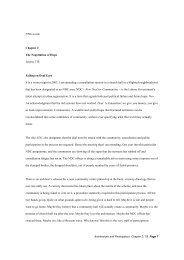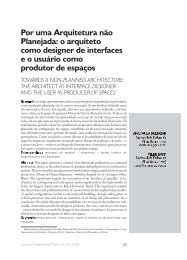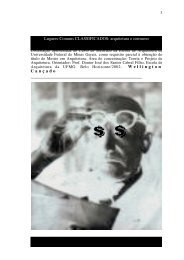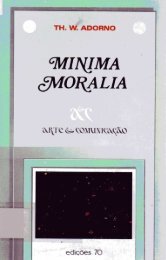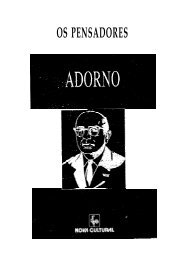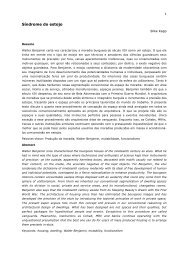Towards a virtual architecture - MOM. Morar de Outras Maneiras ...
Towards a virtual architecture - MOM. Morar de Outras Maneiras ...
Towards a virtual architecture - MOM. Morar de Outras Maneiras ...
Create successful ePaper yourself
Turn your PDF publications into a flip-book with our unique Google optimized e-Paper software.
BALTAZAR DOS SANTOS, Ana Paula. <strong>Towards</strong> a <strong>virtual</strong> <strong>architecture</strong>: Pushing cybernetics from<br />
government to anarchy. In: Kybernetes, Special Issue on Cybernetics and Design, Emerald, 2007.<br />
Abstract<br />
<strong>Towards</strong> a <strong>virtual</strong> <strong>architecture</strong><br />
Pushing cybernetics from government to anarchy<br />
Ana Paula Baltazar<br />
LAGEAR – Graphics Laboratory for Architectural Experience, School of<br />
Architecture, Fe<strong>de</strong>ral University of Minas Gerais, Brazil<br />
Purpose – This paper discusses the possibility of joining cybernetics and <strong>architecture</strong><br />
as a continuous and open process, bridging <strong>de</strong>sign, construction and use, in that which<br />
is called cyber<strong>architecture</strong>.<br />
Design – It <strong>de</strong>velops the hypothesis that cyber<strong>architecture</strong> can benefit from taking the<br />
<strong>virtual</strong> into account in the <strong>de</strong>sign process, so that the architect is no longer the author<br />
of a finished architectural product, but of a set of instruments with which users can<br />
<strong>de</strong>sign, build and use their own environments simultaneously.<br />
Findings – A set of <strong>de</strong>sign principles is systematised and examined in three practical<br />
realms of <strong>de</strong>sign: urban, building and relational, showing cyber<strong>architecture</strong>’s<br />
embryonic feasibility.<br />
Practical implications – Cyber<strong>architecture</strong> implies architects no longer being authors<br />
of finished products and users becoming <strong>de</strong>signers of their own spaces.<br />
Value – Cyber<strong>architecture</strong> avoids the usual cybernetics’ approach based on controlsystem,<br />
indicating a less predictive and, ultimately, anarchic path for architects and<br />
users. It focuses on <strong>architecture</strong>’s intrinsic value as an event, indicating the<br />
possibility of a process-based system, which only exists (or is organised) in presenttime,<br />
when users and instruments (or structures) interact.<br />
Keywords – <strong>de</strong>sign process, <strong>virtual</strong>, user autonomy, interface, anarchy, processorientated<br />
<strong>de</strong>sign<br />
Paper type – Conceptual paper<br />
1. Introduction<br />
The documentary The corporation (2003) states that a corporation has the legal rights<br />
of an individual though has no moral values as an individual, and as an individual it<br />
can be diagnosed as a psychopath. The motivation of the discussion <strong>de</strong>veloped here<br />
comes from the need to stop moving with the flow, in the wave of cybernetics and<br />
new technologies orientated towards corporations, and try and discuss the possibility<br />
of cybernetics orientated towards the individual: instead of organising and governing<br />
systems from the top down, to think of <strong>de</strong>veloping tools or interfaces for possible selforganisation<br />
from the bottom up and, ultimately, envisaging individual autonomy. In<br />
<strong>architecture</strong> this implies an analogy with anarchy instead of the usual analogy with<br />
government (Malatesta, 1987). This means shifting to a process-orientated<br />
production of instruments or interfaces, instead of the usual product-orientated <strong>de</strong>sign<br />
of systems, objects, spaces and events. This also implies to take that which John
Thackara calls ‘the innovation dilemma’ into account, as instead of producing things<br />
for increasing big corporations’ profit, this view needs <strong>de</strong>signers worrying about the<br />
real value of their products or processes to individuals, and how flexible and open to<br />
interaction and change they really are; that is, to worry about ‘why’ <strong>de</strong>sign things<br />
(Thackara, 2000). In other words, instead of <strong>de</strong>signing a fridge that tells people when<br />
their milk is finishing (I would be quite annoyed with such an intelligent friend-fridge<br />
in my house), or <strong>de</strong>signing an intelligent heating system that learns with users’ habit<br />
and saves energy but also stimulates the habitual uses of the space, I believe we, as<br />
individuals, would be better off with the <strong>de</strong>sign of instruments and interfaces enabling<br />
users to keep on <strong>de</strong>signing.<br />
This paper discusses cyber<strong>architecture</strong>, the possibility of <strong>architecture</strong> as a<br />
continuous and open process, bridging <strong>de</strong>sign, construction and use. In this case the<br />
architect is no longer the author of a finished architectural product, but of a set of<br />
instruments with which users can <strong>de</strong>sign, build and use their own environments<br />
simultaneously. This is <strong>de</strong>veloped in three parts. The first part discusses cybernetics<br />
and its implications to <strong>architecture</strong>, the second discusses the <strong>virtual</strong> as a means to<br />
open the <strong>de</strong>sign to users, and the third elaborates the i<strong>de</strong>a of cyber<strong>architecture</strong> on<br />
three practical examples.<br />
The first part, cybernetics and <strong>architecture</strong>, introduces the main features of<br />
second or<strong>de</strong>r cybernetics for the arguments of the paper. It shows those features that<br />
are crucial to the <strong>de</strong>velopment of cyber<strong>architecture</strong> (the inclusion of the observer in<br />
the system, its ethical focus, its conversational basis, and the constructvist approach)<br />
and discusses those concepts that are incompatible with cyber<strong>architecture</strong>’s open<br />
character (autopoiesis, autonomy and fixed-organisation). I must acknowledge here<br />
the influence of Ranulph Glanville, who criticised my first draft for this paper and<br />
introduced me two main sources: his own “Second or<strong>de</strong>r cybernetics”, and Maturana<br />
and Poerksen’s From being to doing. The discussion raised in this part ends up<br />
pointing towards the <strong>virtual</strong>isation of <strong>architecture</strong> and of the <strong>de</strong>sign process as a<br />
means to open up the system’s organisation and to inclu<strong>de</strong> the user as part of the<br />
system.<br />
The second part, the <strong>virtual</strong>isation of <strong>architecture</strong>, discusses the meaning of the<br />
<strong>virtual</strong> as a philosophical concept and its possible application in <strong>de</strong>sign. It draws from<br />
Pierre Lévy and Sanford Kwinter and <strong>de</strong>velops the concepts of potential, real, <strong>virtual</strong><br />
and actual by means of examples from the arts and <strong>virtual</strong> reality. It makes a critique<br />
of representation as a controlled closed-system and proposes a <strong>de</strong>sign approach based<br />
on open process. This evolves from theoretical arguments borrowed from philosophy<br />
(Gilles Deleuze and Félix Guattari), philosophy of science (Bruno Latour and Lucy<br />
Suchman) and <strong>de</strong>sign (Vilém Flusser and John Chris Jones). It argues that<br />
cyber<strong>architecture</strong> is a means to <strong>de</strong>sign responsibly, leaving it open to other people to<br />
keep on <strong>de</strong>signing; <strong>de</strong>signing the interface rather than the finished and closed system<br />
or product.<br />
The third part, a set of <strong>de</strong>sign principles and three practical examples, discusses<br />
some <strong>de</strong>sign principles un<strong>de</strong>rlying creative thinking that can be used in<br />
cyber<strong>architecture</strong>. The principles are introduced and examined in three <strong>de</strong>signs I have<br />
been involved: the first regarding the realm of urban <strong>de</strong>sign, the second regarding the<br />
realm of the building, and the third regarding the relational realm. All three examples<br />
are attempts to create open cybernetic systems (cyber<strong>architecture</strong>s) with participation<br />
of the users in its temporary completion. This leads to the conclusion of the paper,<br />
which stresses the difference between the traditional <strong>de</strong>sign procedure and the one<br />
proposed here; praises the work of Cedric Price as an early <strong>de</strong>velopment of
cyber<strong>architecture</strong>; and asks for architects and <strong>de</strong>signers to abandon the <strong>de</strong>sign of<br />
finished products and closed-systems, and start <strong>de</strong>veloping <strong>virtual</strong> interfaces for<br />
people to keep on <strong>de</strong>signing their own objects, spaces and events.<br />
2. Cybernetics and <strong>architecture</strong><br />
Ranulph Glanville (1997) clearly states that ‘cybernetics <strong>de</strong>serves to be consi<strong>de</strong>red in<br />
its own terms, and the logic and coherence that is within it <strong>de</strong>serves to be <strong>de</strong>veloped<br />
in those terms’. He goes on as to extend this same view to <strong>architecture</strong>, saying that<br />
‘practitioners (sic) seems to have so little regard for its own value that they have<br />
always to <strong>de</strong>scribe it in terms of theories borrowed from other fields, without realising<br />
that <strong>architecture</strong> is the theory in its own right’. As Glanville, I am not concerned here<br />
with semiotics, or autopoiesis, but with the implications of possible <strong>de</strong>velopments of<br />
cybernetics to its own <strong>de</strong>velopments. I am also not interested in a theory of<br />
<strong>architecture</strong> borrowed from any other field, but with <strong>architecture</strong> itself, an event that<br />
only happens when experienced, lived by subjects (individuals), and not controlled<br />
and imposed by corporations. These two concerns, cybernetics and <strong>architecture</strong>,<br />
motivated by the need to create useful things (not only useable as the intelligent<br />
fridge), as Thackara (2000) puts it (borrowing from Bill Buxton), leads to what I<br />
would like to call cyber<strong>architecture</strong>. It is no longer possible to think of <strong>architecture</strong><br />
without thinking of a human-machine relation, that is, to think of cybernetics, even if<br />
not computer-based, as this article illustrates later.<br />
Some features of second or<strong>de</strong>r cybernetics are crucial to the <strong>de</strong>velopment of<br />
cyber<strong>architecture</strong>, mainly the inclusion of the observer in the system, its ethical focus,<br />
its conversational basis, and the constructvist approach. i The inclusion of the<br />
observer and the constructivist approach can be linked together as the observer is no<br />
longer placed outsi<strong>de</strong> the system, as in first or<strong>de</strong>r cybernetics, but constructs the<br />
system through the very act of observation (Hayles, 1999), or, in other words, we<br />
construct our reality through observation. Glanville (n.d.) states that ‘from this<br />
interest in the involvement of the observer ... and a theory of knowledge <strong>de</strong>termined<br />
by a knower rather than simply being “there”, comes an explicit concern for ethics’.<br />
This ethical focus is summarised in Heinz von Foerster’s ethical imperative: ‘act<br />
always so as to increase the number of choices’ (Glanville, n.d.). This means that<br />
ethics is never a pre<strong>de</strong>termined rule, but a responsible choice of the observer (which I<br />
would rather call user or actor). The conversational basis questions the possibility of<br />
any meaning prior to interaction, pointing to circularity and to the impossibility of a<br />
linear system. All these are interrelated and clearly contribute to a process-orientated<br />
and open <strong>de</strong>sign of interfaces leading to cyber<strong>architecture</strong>.<br />
However, some concepts that are at the heart of second or<strong>de</strong>r cybernetics can be<br />
regar<strong>de</strong>d as obstacles for the <strong>de</strong>velopment of cyber<strong>architecture</strong> (perhaps also for<br />
further <strong>de</strong>velopments of cybernetics, but this is not the main concern here). These are<br />
the concepts of autopoiesis, autonomy and fixed-organisation.<br />
According to Humberto Maturana and Francisco Varela (1980), an autopoietic<br />
unity or system is a living-system, such as a biological system as a human body.<br />
Having an i<strong>de</strong>ntifiable boundary is the first key Maturana and Varela <strong>de</strong>scribed in a<br />
six-step methodology to <strong>de</strong>termine whether or not a given unity is autopoietic. ii<br />
Maturana also says that a cell is an example of an autopoietic organisation, while a<br />
ribosome is an example of an allopoietic organisation. iii Even if one does not<br />
un<strong>de</strong>rstand a lot of biology, it is not difficult to see the difference in organisation<br />
between a cell and a ribosome. If on the one hand, a cell is an in<strong>de</strong>pen<strong>de</strong>nt physical<br />
unity, separate from its background, and produced by processes intrinsic in its own
operation, the ribosome, on the other hand, is not entirely produced by processes that<br />
constitute its operation. This i<strong>de</strong>a of an in<strong>de</strong>pen<strong>de</strong>nt living-system, as a cell, with a<br />
clear i<strong>de</strong>ntifiable boundary, having all possible output created from its own input, can<br />
only happen in closed-systems. The point that needs to be ma<strong>de</strong> is that<br />
cyber<strong>architecture</strong> (as I am only concerned with this, and not with other possible<br />
applications of cybernetics) can never be regar<strong>de</strong>d as a closed living-system as it has<br />
no i<strong>de</strong>ntifiable boundaries, frustrating the first rule of autopoiesis and being closer to<br />
an allopoietic system.<br />
Maturana himself strongly criticises the use of autopoiesis to explain social<br />
systems (Maturana and Poerksen, 2004). His argument is that ‘autopoiesis takes<br />
place in a domain in which the interactions of the elements constituting it bring forth<br />
elements of the same kind.... Communications, however, presuppose human beings<br />
that communicate. Communications can only produce communications with the help<br />
of human beings’ (Maturana and Poerksen, 2004). For Maturana (Maturana and<br />
Poerksen, 2004), ‘autopoiesis as a biological phenomenon involves a network of<br />
molecules that produces molecules’ and to replace molecules by communications<br />
would mean to exclu<strong>de</strong> people from the system, that is, to say that communications<br />
produce communications. This closed system is an impossibility for social<br />
phenomena, which have no i<strong>de</strong>ntifiable boundaries as a molecular system has.<br />
In biology and cybernetics an autopoietic system is also regar<strong>de</strong>d as an<br />
autonomous system, as it is self-produced. Autonomy in this context means<br />
in<strong>de</strong>pen<strong>de</strong>nce from external sources or other systems to produce itself. However, if<br />
we examine the origin of the concept of autonomy we can see that it is a moral i<strong>de</strong>a.<br />
Kant formulated it as the ability of people to govern their own <strong>de</strong>cisions by discerning<br />
and enacting of a common moral law. This means that autonomy is not an ethical but<br />
a moral issue. Morals is different to ethics, in that it is applied by others to others<br />
instead of being a ‘property of the observer’ (Glanville, n.d.). This means that only<br />
people can be autonomous, and also that it is not an in<strong>de</strong>pen<strong>de</strong>nt feature or property<br />
of the person, but a relational feature. Nevertheless, even if we disregard this<br />
philosophical meaning of autonomy, and take it merely as “self-government”, we<br />
must be aware that if a system is truly open as to accommodate as many users and<br />
their <strong>de</strong>mands as they may come, this ability to govern itself is not enough. Selfgovernment<br />
is <strong>de</strong>sired and welcome in closed-systems, but in open-systems we must<br />
look for self-anarchy. In other words, there is no way to control, to govern a system<br />
that has no boundaries. The proposal of self-anarchy is a more appropriate approach<br />
as it implies both self-organisation and emergent-organisation instead of a fixedorganisation.<br />
Maturana (Maturana and Poerksen, 2004) states that every autopoietic system<br />
has a fixed-organisation; if the organisation changes the system collapses. Maturana<br />
and Varela (1980) use an interesting distinction between organisation and structure.<br />
They state that ‘the relations that <strong>de</strong>fine a machine as a unity, and <strong>de</strong>termine the<br />
dynamics of interactions and transformations which it may un<strong>de</strong>rgo as such a unity,<br />
constitute the organization of the machine. The actual relations which hold among<br />
the components which integrate a concrete machine in a given space, constitutes its<br />
structure’ (Maturana and Varela 1980). They illustrate that with a toilet, explaining<br />
that regardless of the materials used to make the parts of a toilet, it will still be a toilet<br />
if its organisation is that of a toilet. Changing materials, means changing structure,<br />
not changing the machine as a unity, its organisation (Hayles, 1999). Of course that<br />
spaces, such as a toilet, will always keep its basic organisation, though having<br />
different possible structures. However, other architectural spaces, such as
cyber<strong>architecture</strong>, need not to be so organised; that is, they are not required to be (and<br />
actually it is not <strong>de</strong>sirable that they be) pre<strong>de</strong>fined, having all possible dynamics of<br />
interactions and transformations pre<strong>de</strong>termined. So, the i<strong>de</strong>a of cybernetics<br />
emphasising control-systems, in which <strong>de</strong>signers control both structure and<br />
organisation, restricting users’ behaviour, needs questioning. The <strong>de</strong>sign,<br />
construction and use of spaces can shift their focus to the event and people can<br />
experiment with more freedom, as part of the system. Control, in this case, is no<br />
longer directed towards the final system, though the <strong>de</strong>sign and production of<br />
instruments and interfaces may be controlled. Cyber<strong>architecture</strong> is then a presenttime<br />
emergent system, in which the i<strong>de</strong>a of self-anarchy is more suitable than that of<br />
self-government.<br />
The reason why cyber<strong>architecture</strong> cannot be regar<strong>de</strong>d as an autopoietic system<br />
with i<strong>de</strong>ntifiable boundaries is that it is not a pre<strong>de</strong>termined system, but a social,<br />
relational phenomenon. In other words, the whole i<strong>de</strong>a behind cyber<strong>architecture</strong> is<br />
not only to take users’ interpretation of the system into account and consi<strong>de</strong>r the<br />
construction of the system for the user in analytical ways. Instead, cyber<strong>architecture</strong><br />
<strong>de</strong>pends on really seeing the user as a physical and un<strong>de</strong>termined part of the system.<br />
In this view, the system does not exist prior to its use, but only happens with and in<br />
response to the users. The system is dialogical, and the user triggers communications<br />
within it. The autonomy wished for is that of the users, who will act within the<br />
system according to their own discernment of what they previously know. The<br />
system’s organisation is not fixed, as the function of the spaces and events proposed is<br />
not pre<strong>de</strong>termined in the system, but waits use to actually be temporarily assigned. iv<br />
Thus, once more, it reinforces the impossibility of autopoiesis, which presupposes<br />
fixed-organisation. That is why there is a need to <strong>de</strong>sign instruments and interfaces<br />
open enough, and with no fixed-organisation, so people can join them together in<br />
different combinations to suit their needs and <strong>de</strong>sires. Thus, self-organisation is<br />
possible, though the system is not closed and pre<strong>de</strong>termined.<br />
Cyber<strong>architecture</strong>, as any <strong>virtual</strong> <strong>de</strong>sign proposal, is a cybernetic system in the<br />
sense that it is a feedback system, a circular system, a self-organised (or even better<br />
self-organiseable) system. Regardless of the criticism of autopoiesis and its following<br />
concepts of autonomy and fixed-organisation, cybernetics is still the inseparable<br />
partner for <strong>virtual</strong> <strong>architecture</strong> and <strong>de</strong>sign. It must be emphasised that the cyber of<br />
cyber<strong>architecture</strong>, though can be related to digital technology, is strongly rooted in<br />
cybernetics. This differs to the cyber used before anything that has to do with<br />
technology nowadays, which seems to have started its spread with William Gibson<br />
(1984) coining the term cyberspace. In spite of that, the cyber of cybernetics is very<br />
alive and might not be ignored.<br />
It must be said that the <strong>de</strong>velopments of cybernetics do not concern <strong>architecture</strong>.<br />
In the classic article “The architectural relevance of cybernetics”, Gordon Pask (1969)<br />
mentions the straight relation of both disciplines, as they are ‘operational’, saying that<br />
‘architects are first and foremost system <strong>de</strong>signers’. However, cybernetics <strong>de</strong>velops<br />
from other sort of research, which is not even inspired by <strong>architecture</strong> and its<br />
preoccupations. The relevance of cybernetics for <strong>architecture</strong> is huge, but as Pask<br />
(1969) states, ‘there is … one sense in which the reactive environment is a controller<br />
and another in which it is controlled by its inhabitants’. This alone means a<br />
disturbance of any closed or pre<strong>de</strong>termined system, as the observer is no longer<br />
constructing it by means of interpretation, but actually using and transforming it. The<br />
user is active, becoming an un<strong>de</strong>terminable part of the system. If on the one hand this<br />
can be easily inferred from cybernetics and <strong>architecture</strong>, on the other, most architects
still <strong>de</strong>sign representing predictable patterns of users’ behaviour. That is, most<br />
<strong>de</strong>signed spaces are closed systems in which users’ unpredictable interference is not<br />
always welcome; sometimes, in or<strong>de</strong>r to appropriate of spaces users need to radically<br />
change its pre<strong>de</strong>termined structure and organisation. Cyber<strong>architecture</strong> intends to join<br />
cybernetics and <strong>architecture</strong> acknowledging this fusion as an open system with no<br />
fixed-organisation and with a flexible structure. This means to <strong>virtual</strong>ise both<br />
<strong>architecture</strong> and the <strong>de</strong>sign process.<br />
3. The <strong>virtual</strong>isation of <strong>architecture</strong><br />
One way of looking at the anarchic nature of cyber<strong>architecture</strong> is to examine it as a<br />
<strong>virtual</strong> entity. ‘Virtual’ in computer terminology is usually associated to digital<br />
representation or simulation, meaning something beyond static visual representation<br />
of reality; it indicates an environment where the user can always interact. However,<br />
the philosophical meaning of <strong>virtual</strong> in the age of information and communication<br />
technology (ICT) encompasses more than that. This article claims that ‘<strong>virtual</strong>’ can<br />
be used in <strong>de</strong>sign terminology as a means to open organisation, to create sets of<br />
structures to be organised by users as they wish.<br />
Drawing upon Pierre Lévy (1996), <strong>virtual</strong> can be summarised as ‘latent event’,<br />
which is an event that is present but not manifest. Lévy’s fourfold system shows the<br />
difference between possible and <strong>virtual</strong>, and the interrelationship between possible,<br />
real, <strong>virtual</strong> and actual, in which the <strong>virtual</strong> is not opposed to the real, but to the<br />
actual, which is a present-time manifestation of the always existent and latent<br />
<strong>virtual</strong>ity. The real, on the other hand, is manifest at the level of substance, and is<br />
opposed to the potential, which, tough latent, also belongs to the realm of substance.<br />
The <strong>virtual</strong> belongs to the realm of the event, the real to the realm of substance.<br />
Virtualisation is <strong>de</strong>fined as the inventive passage from a solution to a problem, the<br />
opposite of problem-solving. This problematising process is crucial to <strong>architecture</strong>, as<br />
opposed to the usual <strong>de</strong>sign strategy based on problem-solving. The relevance of the<br />
latent event in <strong>architecture</strong> is my concern here. Lévy (1996) stresses the importance<br />
of the event as distinct and separate from substance, though both work together in the<br />
world. The role of the architect is then to <strong>de</strong>sign <strong>virtual</strong> instruments or interfaces with<br />
which users can play with as to actualise them. That is, architects should not merely<br />
realise their <strong>de</strong>signs.<br />
According to Sanford Kwinter (2001), <strong>architecture</strong> was the first discipline to<br />
<strong>de</strong>clare its postmo<strong>de</strong>rn emancipation from the Mo<strong>de</strong>rn Movement, and this<br />
postmo<strong>de</strong>rn emancipation was a corrupted and inward critique of the innovation<br />
proposed by the mo<strong>de</strong>rn avant-gar<strong>de</strong>, emerging from a ten<strong>de</strong>ncy to mediocrity. So,<br />
postmo<strong>de</strong>rn <strong>architecture</strong> is an inward critique of mo<strong>de</strong>rn <strong>architecture</strong> ‘reproducing’ it<br />
rather than questioning and <strong>de</strong>veloping it further ‘following’ from it. Gilles Deleuze<br />
and Félix Guattari (1999) distinguish between two mo<strong>de</strong>ls: the ‘reproduction’ mo<strong>de</strong>l<br />
and the ‘following’ mo<strong>de</strong>l. ‘Reproducing implies the permanence of a fixed point of<br />
view that is external to what is reproduced: watching the flow from the bank. But<br />
following is something different from the i<strong>de</strong>al of reproduction’ (Deleuze and<br />
Guattari, 1999). ICT is used in <strong>architecture</strong> according to the mo<strong>de</strong>l of reproduction,<br />
based on a fixed point of view and the representation of what already exists, as an<br />
inward critique. The following mo<strong>de</strong>l, in contrast, is based on <strong>de</strong>stabilising what<br />
already exists and looking for novelty. Consi<strong>de</strong>ring <strong>architecture</strong> as an open system,<br />
the following mo<strong>de</strong>l suits best the potential of both <strong>architecture</strong> and ICT in relation to<br />
the whole dynamic system of production and consumption of spaces, beyond<br />
representation.
The difference between reproduction and following mo<strong>de</strong>ls can be investigated<br />
as the distinction between substance and event. Substance concerns the relationship<br />
of the possible to the real; event, the relationship of the <strong>virtual</strong> to the actual. The two<br />
approaches are exemplified in two early explorations of <strong>virtual</strong> reality (VR). First,<br />
Ivan Sutherland’s helmet-set and Morton Heilig’s Sensorama, which were created to<br />
reproduce some isolated aspects of the physical world in the digital. The helmet-set<br />
enabled users to see vi<strong>de</strong>o images as they saw three-dimensional things in the world;<br />
users could also see both physical and digital worlds simultaneously. The Sensorama,<br />
apart from stereoscopic vision, also reproduced smell, vibration and sounds from the<br />
physical world. In both <strong>de</strong>vices the potential is ren<strong>de</strong>red real by simulating isolated<br />
physical experiences, which are then experienced by users repetitively; their <strong>de</strong>signs<br />
focus on reproducing physical qualities in digital environments, on realising the<br />
reproductive potential of digital technology.<br />
The second example is Lygia Clark’s work, v in particular Mask with mirrors<br />
(1967), which celebrates real interactivity by holding small moveable mirrors in front<br />
of the eyes, juxtaposing and fracturing reflections of the self and the surrounding<br />
world. Simone Osthoff (1997) places this work besi<strong>de</strong> Sutherland’s helmet-set as the<br />
primitives of VR. In both cases, the spectator has a bodily experience. However,<br />
with Sutherland’s helmet-set the spectator experiences a reproduction, a simulation<br />
given a priori, while with Clark’s headset spectators become active participants in<br />
their own liberation as individuals, connecting art and life through their own<br />
experience (Carvajal and Ruiz, 1999 and Osthoff, 1997). In Clark’s case, the artist<br />
works as a <strong>de</strong>signer who is not limited to ren<strong>de</strong>ring the potential into real, as ‘a person<br />
who induces and channels experiences’ (Borja-Villel, 1997), creating a place for<br />
experience, consi<strong>de</strong>ring the <strong>virtual</strong> to be actualised by the spectator. In other words,<br />
although substance results from art or <strong>de</strong>sign, the final result is not necessarily<br />
substance; the final result is always the individual experience of the event.<br />
Unfortunately, most <strong>de</strong>signs take substance as the final result, and the event, the<br />
actualisation of their <strong>virtual</strong>ity, becomes a consequence rather than part of the <strong>de</strong>sign.<br />
Clark takes advantage of the event as the core of her work, consciously focusing on<br />
the <strong>virtual</strong> to be actualised by the spectator.<br />
Clark’s Sensorial gloves (1968), proposes a rediscovery of touch. Participants<br />
experience different combinations of gloves and balls of different kinds, sizes,<br />
textures and weights, alternating with holding the balls with bare hands. The physical<br />
perception of touch is enhanced by awakening the participants’ awareness beyond<br />
habitual experience. Jaron Lanier, one of the pioneers of research on touch in VR<br />
systems leading to experiments with interactive gloves, <strong>de</strong>scribes a similar sensitising<br />
effect resulting from immersion in VR:<br />
There’s this won<strong>de</strong>rful phenomenon where when you’re insi<strong>de</strong> a <strong>virtual</strong> world<br />
and if you take off the head-mounted display and look around, the physical<br />
world takes on a sort of super-real quality where it seems very textured and<br />
beautiful, and you notice a lot of <strong>de</strong>tails in it because you’ve gotten used to a<br />
simpler world. So there is actually a sensitivity-enhancing effect (Leeson,<br />
1996).<br />
Although these two sensitising effects are similar, their differences indicate an<br />
important distinction in <strong>de</strong>sign: on the one hand, a predictable substance-based<br />
<strong>de</strong>sign; and on the other hand, the <strong>de</strong>sign of an unpredictable event; the <strong>de</strong>sign of the<br />
<strong>virtual</strong>.
The rediscovery of touch, the enhancement of perception, is the ‘final’ product<br />
of Clark’s work, a product which is not realised in terms of substance but is <strong>virtual</strong><br />
and <strong>de</strong>pends on the spectator’s participation in or<strong>de</strong>r to happen. Clark’s work points<br />
towards <strong>de</strong>signing the event without <strong>de</strong>signing the final experience of the user. In her<br />
work, the enhancement of perception is achieved by experiencing the work. On the<br />
other hand, the sensitising experience <strong>de</strong>scribed by Lanier happens when one leaves<br />
the VR system. The aim of the system, and of the <strong>virtual</strong> environments it shows, is<br />
not to enhance the participants’ perception of the physical world but to partially<br />
reproduce it in the digital environment. The VR he <strong>de</strong>scribes has as its ‘final’ product<br />
the presentation of the <strong>virtual</strong> environment to the users who, immersed in the system,<br />
have most of their senses restricted. The product of such a system is substance-based:<br />
the realisation of the potential of the physical world in digital format, often reducing<br />
it. It aims not at enhancing perception of the physical qualities of the world, but at<br />
extending the world, mainly for communication purposes, by reproducing physical<br />
qualities digitally.<br />
The <strong>de</strong>sign of VR systems and of <strong>virtual</strong> environments, and <strong>de</strong>sign in general,<br />
including <strong>architecture</strong>, is often concerned with realising potentials, with solving<br />
established problems rather than raising questions for the user. Clark’s Mask with<br />
mirrors and Sensorial gloves are <strong>de</strong>signed creating not a result in terms of substance,<br />
but rather ‘instruments’ which enhance experience by raising questions to be<br />
answered differently by each spectator. Substance works as a key to open up the<br />
<strong>virtual</strong>ity of the work when the spectator becomes a participant, actualising it. These<br />
examples do not <strong>de</strong>sign the experience, but create a piece for experience. They<br />
provi<strong>de</strong> the user with tools to enable them to play with their own sensory capabilities,<br />
without leading them to any pre<strong>de</strong>signed perception. The participant is pushed to<br />
explore new territories, perhaps without moving, exploring new relationships with<br />
things in a non-habitual way.<br />
If the <strong>de</strong>signer assumes the reproduction mo<strong>de</strong>l based on the atomist approach<br />
by <strong>de</strong>signing the experience, then experience itself will be limited by the restrictive<br />
control of the <strong>de</strong>signer. This is usually the <strong>de</strong>sign approach, which Lebbeus Woods<br />
(1996) <strong>de</strong>fines as ‘a means of controlling human behaviour, and maintaining this<br />
control into the future’. But if <strong>de</strong>signers assume the following mo<strong>de</strong>l, <strong>de</strong>signing for<br />
experience, they either give up control altogether, or control the production of<br />
instruments without restricting the user experience. Unfortunately, <strong>de</strong>signers usually<br />
set an agenda based on substance. This article indicates cyber<strong>architecture</strong> as a<br />
possible means to overcome this.<br />
Cyber<strong>architecture</strong> is an event-based space directly <strong>de</strong>pending on people’s<br />
present-time interaction. Cyber<strong>architecture</strong> is in principle an open process which<br />
recognises that there is no such a thing as finished <strong>architecture</strong>, because people are<br />
always part of <strong>architecture</strong> regardless of it not being <strong>de</strong>signed as an open process.<br />
Bruno Latour (1999) summarises this in his Pandora’s hope when he states that<br />
instead of replacing one comman<strong>de</strong>r by another the rea<strong>de</strong>r should recognise ‘the<br />
impossibility of speaking of any sort of mastery in our relations with nonhumans,<br />
including their supposed mastery over us’. Latour (1999) <strong>de</strong>monstrates that<br />
‘responsibility for action must be shared among the various actants’. In line with<br />
Lucy Suchman’s argument on agency (Suchman, 1999), he <strong>de</strong>monstrates that<br />
regardless of what is at stake, responsibility for action always concerns the<br />
interrelationship of everything involved, and nothing has the sole power of<br />
premeditated mastery.
In <strong>architecture</strong> this means that regardless of the intent of <strong>de</strong>signers to master<br />
their plans and to predict the use of the spaces they <strong>de</strong>sign, the final use of spaces will<br />
always happen according to the interrelationship of every actant involved, including<br />
the very space itself. Of course that the more closed, finished and restrictive the space<br />
is, the more difficult for people to use it differently to the inten<strong>de</strong>d plan. This<br />
limitation is well explained by Vilém Flusser (1999) when <strong>de</strong>fining <strong>de</strong>sign as<br />
‘obstacle for/to the removal of obstacles’. Flusser (1999) argues that everything<br />
<strong>de</strong>signed is always an obstacle, as ‘an “object of use” is an object which one uses and<br />
needs to get other objects out of the way’. According to Flusser (1999), every <strong>de</strong>sign,<br />
be it substance-based or event-based, is an obstacle with a purpose. However, he puts<br />
an interesting question: ‘what form must I give these projected <strong>de</strong>signs so that people<br />
coming after me can use them to help them to continue and at the same time avoid<br />
being obstructed as much as possible?’ (Flusser, 1999). This question has no direct<br />
answer, but opens up a discussion on responsibility, which Flusser (1999) <strong>de</strong>fines as<br />
‘openness to other people’. According to him, the problem is that most <strong>de</strong>signs are<br />
created irresponsibly, that is, orientated to the object rather than to its openness to<br />
people. In his words ‘the more I direct attention towards the object in the creation of<br />
my <strong>de</strong>sign (the more irresponsibly I <strong>de</strong>sign it), the more the object will obstruct those<br />
coming after me’ (Flusser, 1999). Moreover, Flusser stresses that this irresponsible<br />
<strong>de</strong>sign has been almost inevitable since the Renaissance, as since that time there is a<br />
need to master everything.<br />
If we learn from Latour that there is no mastery, and from Flusser that <strong>de</strong>signers<br />
are imposing their will to mastery onto their <strong>de</strong>signs, we can start questioning the<br />
irresponsible <strong>de</strong>sign and envisaging that which Flusser (1999) calls inter-subjective,<br />
or dialogical, or responsible <strong>de</strong>sign. This is the aim of cyber<strong>architecture</strong>, <strong>de</strong>signed as<br />
an open process, without attempting to <strong>de</strong>fine a finished product, recognising that ICT<br />
can bring more to <strong>architecture</strong> than shifting the place of command from the object to<br />
the subject or to technology by acknowledging that in fact there is no need for any<br />
command.<br />
According to John Chris Jones (1991), ‘the <strong>de</strong>sign-as-process outcome is the<br />
<strong>de</strong>sign process’. Jones’ critique of <strong>de</strong>sign methods, and particularly of his approach<br />
to <strong>de</strong>sign-as-process, is that the method ends up being a product. In his words: ‘the<br />
fault in method-making was that we ma<strong>de</strong> methods as “products” and han<strong>de</strong>d them on<br />
to the <strong>de</strong>signers expecting them to use them, as “tools”, as a means to an end. Which<br />
became a logical trap, turning the i<strong>de</strong>a of process into its opposite’ (Jones, 1991).<br />
Moreover he states that they ‘didn’t realise that the people inhabiting the world<strong>de</strong>signed,<br />
if [the method-makers] changed to process-<strong>de</strong>sign, have to be <strong>de</strong>signers,<br />
everyone of them’ (Jones, 1991). Jones proposes the continuation of <strong>de</strong>sign into the<br />
world. This has two implications: first, if there is any <strong>de</strong>sign method at all it is not a<br />
product; that is, it is not finished and ready to be used by <strong>de</strong>signers. The method, or<br />
set of rules, or directions, must be open enough to enable architects or <strong>de</strong>signers to<br />
keep <strong>de</strong>signing. Second, the <strong>de</strong>sign-as-process produced by <strong>de</strong>signers (which I call<br />
interfaces or instruments) are to be interacted with by users, and only them become<br />
temporarily complete. This means that there is no pre<strong>de</strong>termined end, only an open<br />
means to achieve whatever end results from interaction.<br />
Jones’ <strong>de</strong>sign-as-process and Flusser’s responsible <strong>de</strong>sign are yet abstract i<strong>de</strong>as<br />
that can very easy become a method-product, as Jones have already criticised.<br />
Looking at <strong>architecture</strong>’s methods, it is not difficult to un<strong>de</strong>rstand that since the<br />
Renaissance there is a ten<strong>de</strong>ncy to create mo<strong>de</strong>ls and rules that can be reproduced by<br />
other architects. vi These methods are always prescriptive no matter if based on moral
principles, nature’s laws or are a set of rules drawn from the architect’s belief. They<br />
usually become a black box that people use ignoring the nature of their principles<br />
(Banham, 1999). Taking the <strong>virtual</strong> into account in the <strong>de</strong>sign process is a means to<br />
overcome these usual problems, as <strong>de</strong>monstrated above with the work of Clark.<br />
4. A set o <strong>de</strong>sign principles and three practical examples<br />
If we are moving in the direction indicated by Jones, <strong>de</strong>signing <strong>de</strong>signing, that is,<br />
keeping <strong>de</strong>sign open for people to keep <strong>de</strong>signing, we need to do that responsibly, as<br />
wants Flusser. It is necessary to <strong>de</strong>sign spaces or instruments open enough not to<br />
obstruct people, so they can be creative. We must bear in mind that ICT still enables<br />
the most <strong>de</strong>mocratic environments for creative thinking and acting. The analogy with<br />
computer programs here is inevitable. To look at cyber<strong>architecture</strong> as programming<br />
is an alternative to prescriptive drawings of finished buildings. In this context<br />
programming means not to predict or pre<strong>de</strong>termine the outcome, but to create tools or<br />
environments open to people’s interaction. This interaction will really trigger a<br />
process between users and the machine as to create specific outcome for each case.<br />
This can be seen in commercial software such as Macromedia Director and Flash,<br />
which are programmed so people can create their own programs within them, with<br />
more or less openness <strong>de</strong>pending on their ability and will. These sorts of software, as<br />
also other <strong>de</strong>sign tools said to enable creative thinking, have already been studied.<br />
The <strong>de</strong>sign principles un<strong>de</strong>rlying them can also be used in <strong>architecture</strong>. In fact, they<br />
are crucial to <strong>virtual</strong> <strong>architecture</strong>.<br />
The creative potential of tools is found to be crucial to any <strong>de</strong>sign tool or<br />
environment. According to Mitchel Resnik and his colleagues (2005), ‘almost by<br />
<strong>de</strong>finition creative work means that the final <strong>de</strong>sign is not necessarily known at the<br />
outset, so users must be encouraged to explore the space’. The <strong>de</strong>sign principles<br />
<strong>de</strong>veloped by them are <strong>de</strong>scribed here.<br />
Drawing from Resnick and his colleagues (2005), the first four features of a<br />
<strong>virtual</strong> <strong>de</strong>sign are related to <strong>de</strong>sign supporting exploration. They are: i) the easiness to<br />
try things out and undo them, ii) the self-revealing flexibility enabled by the <strong>de</strong>sign<br />
(interface), because if it is not apparent it will not be used; iii) the easiness to use for<br />
first timers, though not banal to experts; and iv) the pleasure and fun in using the<br />
<strong>de</strong>sign (interface), so people will not need to concentrate their efforts in learning the<br />
environment but on playing. Apart from that, they also mention an important feature<br />
that should come together with the easiness for first timers (‘low threshold’) and the<br />
sophistication for experts (‘high ceiling’), which they call ‘wi<strong>de</strong> walls’. This feature<br />
concerns the support and suggestion of a wi<strong>de</strong> range of explorations. The best<br />
example of this is traditional LEGO bricks and the MIT’s programmable LEGO<br />
bricks, with which kids are encouraged to ‘create anything from a robotic creature to a<br />
“smart” house to an interactive sculpture to a musical instrument’ (Resinick at al,<br />
2005). Furthermore, it needs to be open to different users; that is, to be able to<br />
accommodate different procedures of use. As it also should support collaboration and<br />
interchange, which means that it can be used by teams in collaboration and that it is<br />
open to accept other pieces or logics of use not <strong>de</strong>signed in it.<br />
Three <strong>de</strong>signs I have been involved with are examples of cyber<strong>architecture</strong>’s, or<br />
<strong>virtual</strong> <strong>architecture</strong>’s, principles set up above, though the first two are not yet hybrid<br />
environments, but steps towards it. They are <strong>de</strong>velopments of three different realms:<br />
urban, building and relational. First, in the realm of urban <strong>de</strong>sign, is the project we<br />
presented for a competition of i<strong>de</strong>as for the Plan of the Technological Park of Belo<br />
Horizonte, Brazil. vii Second, in the realm of the building, is the ‘interface of
spatiality’ <strong>de</strong>veloped by our research group <strong>MOM</strong>/LOW (living in other ways). viii<br />
And third, in the relational realm, which is the current focus of our investigation at<br />
LAGEAR (Graphics Laboratory for Architectural Experience), is the project<br />
“Occupying Spaces”, a partnership with the ONG Oficina <strong>de</strong> Imagens, which<br />
intention is to create interfaces for spatialisation of communication connecting people<br />
of two remote physical places. ix<br />
In the first case the <strong>virtual</strong> is taken into account to establish an open and abstract<br />
logic of occupation. Instead of <strong>de</strong>fining the roads, pavement and plots, we propose<br />
only a main road and create a very simple set of rules for occupation. These rules are<br />
based on what we call relative units of occupation (RUsO), which are stripes placed<br />
si<strong>de</strong> by si<strong>de</strong> perpendicular to the road. Each RUO has seven metres in width and<br />
varies in length. The rules state that:<br />
i) Everyone acquiring RUsO ought to take at least three of them, and if RUsO<br />
are to be left between your set and the neighbour’s, these can never be less than<br />
three. This guarantees that the minimum size of the final plot will always be<br />
greater than the required by the local urban legislation.<br />
ii) The pavement is of responsibility of the property and must give continuity to<br />
the neighbour’s pavement, though it is not obligatory that it form a parallel line<br />
with the road.<br />
iii) At least at every set of seven consecutive RUsO it must have a connection,<br />
by means of pavement, between the road and the bushes or the stream behind<br />
them, <strong>de</strong>pending on the si<strong>de</strong> of the road they are.<br />
These rules are in fact our <strong>de</strong>sign proposal, and they are like abstract objects or<br />
obstacles intending to obstruct the least possible, attempting to be responsible. They<br />
aim to enable future architects <strong>de</strong>signing the buildings of the Park to keep <strong>de</strong>signing<br />
the Park. This is the case of <strong>de</strong>signing responsibly a logical structure of occupation,<br />
leaving it open to other architects to keep <strong>de</strong>signing from it. Even if a very limited<br />
example, this non-plan strategy was proposed in opposition to predicting the final<br />
spatial configuration of the Park and limiting the architects to place their <strong>de</strong>signs in a<br />
pre-established grid, without taking part in the <strong>de</strong>sign of the Park. It points in the<br />
direction of <strong>de</strong>signing an open urban structure, taking the <strong>virtual</strong> into account, as the<br />
<strong>de</strong>sign is kept open to other architects. Whether or not these architects will keep their<br />
<strong>de</strong>signs open is another matter. The final <strong>de</strong>sign of the Park, as we propose, could<br />
become as close as the winner <strong>de</strong>sign, as its openness would <strong>de</strong>pend on other people’s<br />
<strong>de</strong>signs. But this is a risk we must take if we are willing to open up our <strong>de</strong>signs to<br />
other people, to <strong>de</strong>sign interfaces rather than products.<br />
The second example, the interface of spatiality, is more concrete than the<br />
abstract logic of the RUsO, as its application is more direct; that is, users can<br />
simultaneously <strong>de</strong>sign and build their spaces. In this case the <strong>virtual</strong> is taken into<br />
account to open the <strong>de</strong>sign for user interaction without predicting the outcome. This<br />
interface is a set of plastic pipes—with modular sizes of 60 cm, 120 cm and 180 cm—<br />
spatial joints ma<strong>de</strong> of laminated wood, clothes of different fabric, size and colour,<br />
ropes and pins to stabilise the structure. The general i<strong>de</strong>a was to <strong>de</strong>sign a kit of parts<br />
easy enough to assemble so people could experiment different spatial arrangements.<br />
The aim of this interface is not only playful, which has proven to be a great success,<br />
but mainly social, that is, to check people using it in or<strong>de</strong>r to perfect it as a building
system to be used by low-income families and individuals to <strong>de</strong>ci<strong>de</strong> upon and build<br />
their own spaces.<br />
Observing the playful uses of the interface and a pilot test with a group of<br />
teenagers of a favela in Belo Horizonte, Brazil, we can say that people are not passive<br />
in relation to space because they are naturally passive. People are quite active when<br />
given the opportunity, that is, if the space is not so obstructive as to discourage people<br />
to make changes. It ma<strong>de</strong> us question the fixing of most spaces and how people are<br />
willing to play with space, to change it, when faced with challenges and possibilities.<br />
When interacting with this interface people are at the same time <strong>de</strong>signing and<br />
building. This kit of parts enables continuity of <strong>de</strong>sign into the world, that is,<br />
ourselves, the architects, are no longer the authors of a work, a finished spaceproduct;<br />
we only provi<strong>de</strong> means, instruments, interfaces, so people can <strong>de</strong>sign their<br />
own spaces.<br />
This kit—this <strong>de</strong>sign—has most of the features <strong>de</strong>scribed above. The kit is very<br />
easy to use, as its pieces are very light and not too big. Everyone sees its potential<br />
flexibility and is able to try it out and undo what is done, even though the connection<br />
pieces sometimes make the joints too tight to be undone. We have tested its use in<br />
situations in which we assembled a space and people could change it, and in situations<br />
in which the kit is there unassembled and people need to figure out what to do. In<br />
both cases the users had no difficulty in playing with it, and also architects were quite<br />
kin on figuring out ways for exploring the interface beyond its obvious potential,<br />
which is to create orthogonal spaces. The playful aspect of the kit was certainly<br />
achieved, but it still lacks ‘wi<strong>de</strong> walls’; that is, its repertoire of bits and pieces is very<br />
limited and limiting of what can be done, and it also needs more flexibility to accept<br />
other pieces not <strong>de</strong>signed to be used with it. We intend to keep working on it and try<br />
and resolve these faults.<br />
Nevertheless, one of the most important features of this kit of parts is that it<br />
transforms the logic of <strong>de</strong>signing and building: <strong>de</strong>sign is no longer an intellectual<br />
process of foreseeing a finished product, and construction a hard process which never<br />
welcome workers’ <strong>de</strong>cisions. Design becomes a process of producing instruments or<br />
interfaces for users, and users become at the same time <strong>de</strong>signers and buil<strong>de</strong>rs. This<br />
interplay of <strong>de</strong>signing and building as users’ activity, on the one hand, and <strong>de</strong>signing<br />
interfaces as architects’ activity on the other, is crucial to the <strong>de</strong>velopment of<br />
cyber<strong>architecture</strong>, and of any <strong>virtual</strong> <strong>architecture</strong>.<br />
In the third case, the project “Occupying Spaces”, the intention was to enable<br />
socially exclu<strong>de</strong>d people from two remote places to establish relations by means of a<br />
hybrid of physical and digital spaces; in other words, to <strong>de</strong>sign a <strong>virtual</strong> space for<br />
remote communication, a sort of third space that only emerges in present-time with<br />
people’s interaction.<br />
If we believe as Norbert Wiener (1954) does, that messages and communication<br />
facilities tend to play an ever-increasing part in the <strong>de</strong>velopment of society, we can no<br />
longer ignore communication as the main condition for the production of spaces. In<br />
this way, not only communication is crucial, but also the spaces that emerge with it.<br />
Usually, communication interfaces, the spaces of communication, are not <strong>de</strong>signed as<br />
‘places’. The telephone is an example: an instrument which enables communication<br />
and at the same time emphasizes the placelessness of the meeting. The two people<br />
communicating by phone stay in their original places, without the phone connection<br />
creating any sort of shared place. Following the logic of <strong>de</strong>signing <strong>virtual</strong> entities, we<br />
created an interactive visual circuit connecting two different favelas in Belo Horizonte<br />
in one evening. For that we have used the Internet with web cameras and a set of
projected interactive environments, so people not only interacted with each other<br />
remotely, but created their own spaces by means of projected digital images, as they<br />
communicated and interacted with the digital interfaces. We <strong>de</strong>signed collaborative<br />
interactive interfaces, which were projected enabling people to interact with each<br />
other and with the environment by means of gesture (using different coloured lights in<br />
their hands). Some interfaces were puzzle based, requiring two users collaborating in<br />
or<strong>de</strong>r to move the pieces to form an image, others enabled more freedom, as the one<br />
which is a sort of digital graffiti, with which people could create whatever they want.<br />
The two main features of this experiment are to enable the emergency of a third<br />
space, a shared place, as people interact with each other and with the hybrid<br />
environment, and to have ‘wi<strong>de</strong>-walls’, as the physical space can accommodate other<br />
projections or other events people could propose, and also, the Internet connection<br />
can lead to other digital environments available on the web without loosing the<br />
remote connection.<br />
5. Conclusion<br />
It is important to distinguish between two approaches to <strong>de</strong>sign. First, the traditional<br />
<strong>de</strong>sign, the one in which architects make themselves acquainted with possible uses of<br />
the space in question and anticipates these in a finished proposal of space. This is as<br />
<strong>de</strong>terminist as every Mo<strong>de</strong>rnist <strong>architecture</strong>, which has the architect as the author of a<br />
finished product. The other, the open or <strong>virtual</strong> <strong>de</strong>sign, in which cyber<strong>architecture</strong> is<br />
inclu<strong>de</strong>d, is the one in which architects un<strong>de</strong>rstand the way people <strong>de</strong>al with their<br />
spaces in or<strong>de</strong>r to create means for a continuous <strong>de</strong>sign proposal. This, though the<br />
interface <strong>de</strong>signed can be <strong>de</strong>termined, is not <strong>de</strong>terminist, as the space itself <strong>de</strong>pends<br />
on people’s interaction to happen—be it by <strong>de</strong>signing and building simultaneously, be<br />
it by merely interacting and completing the building temporarily when having<br />
feedback from the physical and/or digital structures.<br />
It is crucial to cyber<strong>architecture</strong>, as an open <strong>de</strong>sign process, to keep the product<br />
open to users interaction, which means that the ones <strong>de</strong>signing must un<strong>de</strong>rstand how<br />
people <strong>de</strong>al with their daily spaces, but also be able to create something that moves<br />
beyond reproducing patterns. Designers of interfaces, be them architects or users,<br />
need to evaluate which features are of collective <strong>de</strong>cision and which are of individual<br />
<strong>de</strong>cision in or<strong>de</strong>r to produce an interface whose <strong>de</strong>termined bits are related to<br />
collective <strong>de</strong>cision and the open bits related to individual <strong>de</strong>cisions. The ability to<br />
separate collective and individual features when looking at how people <strong>de</strong>al with their<br />
spaces is more important than to i<strong>de</strong>ntify their needs, as the purpose is not to solve a<br />
problem but to create means for users to solve their specific problems. So, instead of<br />
planning for the users or with the users, the non-plan strategy needs attention. In<br />
or<strong>de</strong>r to enable users autonomy and engagement in the constant production of their<br />
spaces the architect must create instruments, interfaces.<br />
Sometimes these instruments for autonomy are already out there in the<br />
environment, and the last thing nee<strong>de</strong>d is a <strong>de</strong>signed building or an urban planning.<br />
According to Arata Isozaki (2003), Price’s proposal for the CCA Competition for the<br />
Design of Cities in 1999, ‘A Lung for Midtown Manhattan’, was actually not a <strong>de</strong>sign<br />
proposal ‘but rather to let the site remain an open urban space—his own unique<br />
interpretation of ma.’ This <strong>de</strong>signless proposal was recognised by judges Isozaki and<br />
Philip Johnson as the best one, though Johnson was not prepared to award him the<br />
first prize arguing that ‘if his proposal comes first, the competition will forfeit all<br />
social significance’ (Isozaki, 2003). What he meant by social significance is not quite<br />
certain, as Price’s proposal seems to be the best suited to social significance in long
term. However, the immediate social significance of the competition seems to be<br />
un<strong>de</strong>rstood as having a product, regardless of its relevance or even of its real<br />
necessity. This was not the first time Price proposed not to build as a <strong>de</strong>sign proposal.<br />
An often quoted example of his attitu<strong>de</strong> is his statement that ‘the architect/planner<br />
must exercise all his expertise, on being asked for artifactual conditioning, on the<br />
relevance of or necessity for doing anything at all. (The best technical advice may be<br />
that rather than build a house your client should leave his wife.)’ (Price, 1966).<br />
While architects such as Johnson still try to keep control over <strong>de</strong>sign by means<br />
of pre<strong>de</strong>termined styles and expected attitu<strong>de</strong>s towards <strong>de</strong>sign, Price moved much<br />
further than this proposing a value-free <strong>architecture</strong> in which people should be able to<br />
add their value and create their own meaning. He was concerned with time and social<br />
relations and not with architectural products. He argued that ‘no one should be<br />
interested in the <strong>de</strong>sign of bridges—they should concern with how to get to the other<br />
si<strong>de</strong>’ (Price, 2003). This attitu<strong>de</strong> towards problematising relations rather than<br />
working or reworking obvious spatial solutions makes Price central to the discussion<br />
on cyber<strong>architecture</strong>. This distinction between Price and Johnson is similar to the<br />
distinction Henri Lefebvre (1991) makes between users and architects. Lefebvre<br />
(1991) adopts the term ‘lived space’ to distinguish between users’ and architects’<br />
approach to space: for users space is always lived—relational, subjective and<br />
concrete—, while for professionals such as architects, urbanists and planners, space is<br />
a representation—conceived and abstract. Cyber<strong>architecture</strong> abandon the si<strong>de</strong> of<br />
architects, abstract, pre<strong>de</strong>termined and dominant spaces, and join the si<strong>de</strong> of users,<br />
looking at the open features of spaces—relational, subjective and concrete.<br />
References<br />
Baltazar, A. P. (2007), “<strong>Towards</strong> a <strong>virtual</strong> <strong>architecture</strong>: the mobility of essences and<br />
the ‘open-in-hand’ in the production-consumption of spaces”, in Proceedings<br />
of Architecture and Phenomenology International Conference, Technion,<br />
Haifa.<br />
Banham, R. (1999), “A black box: the secret profession of <strong>architecture</strong>”, in A critic<br />
writes: essays by Reyner Banham, Univ. of California Press, Berkeley; Los<br />
Angeles; London, pp. 292–99.<br />
Borja-Villel, M. J. (1997), Lygia Clark, Fundación Antoni Tàpies, Barcelona.<br />
Carvajal, R. and Ruiz, A. (1999), The experimental exercise of freedom: Lygia Clark,<br />
Gego, Mathias Goeritz, Hélio Oiticica and Mira Schen<strong>de</strong>l, Museum of<br />
Contemporary Art, Los Angeles.<br />
Choay, F. (1997), The rule and the mo<strong>de</strong>l: on the theory of <strong>architecture</strong> and<br />
urbanism, MIT Press, Cambridge.<br />
Deleuze, G. and Guattari, F. (1999), A thousand plateaus: capitalism and<br />
schizophrenia, Athlone, London.<br />
Flusser, V. (1999), “Design: obstacle for/to the removal of obstacles”, in Flusser, V.<br />
(Ed.), The shape of things: a philosophy of <strong>de</strong>sign, Reaktion, London, pp. 58–<br />
61.<br />
Gibson, W. (1984), Neuromancer, Grafton Books, London.
Glanville, R. (1997), “Communication: conversation 1”, Cybernetics and human<br />
knowing: a journal of second or<strong>de</strong>r cybernetics and cyber-semiotics, Vol. 4,<br />
No. 1. Available http://www.imprint.co.uk/C&HK/vol4/v4-1RG.htm<br />
Glanville, R. (n.d.), “Second or<strong>de</strong>r cybernetics”,<br />
http://homepage.mac.com/WebObjects/FileSharing.woa/wa/<strong>de</strong>fault?user=ranu<br />
lph&templatefn=FileSharing1.html&xmlfn=TKDocument.1.xml&sitefn=Root<br />
Site.xml&aff=consumer&cty=US&lang=en<br />
Hayles, N. K. (1999), How we became posthuman: <strong>virtual</strong> bodies in cybernetics,<br />
literature, and informatics, The University of Chicago Press, Chicago.<br />
Isozaki, A. (2003), “Erasing <strong>architecture</strong> into the system”, in Obrist, H. U. (Ed.),<br />
Re:CP by Cedric Price, Birkhäuser, Basel, pp. 25–52.<br />
Jones, J. C. (1991), Designing <strong>de</strong>signing, Architecture <strong>de</strong>sign and technology press,<br />
London.<br />
Kwinter, S. (2001), Architectures of time: towards a theory of the event in mo<strong>de</strong>rnist<br />
culture, MIT Press, Cambridge.<br />
Latour, B. (1999), Pandora’s hope: essays on the reality of science studies, Harvard<br />
UP, Cambridge.<br />
Leeson, L. H. (1996), “Jaron Lanier interviewed by Lynn Hershman Leeson”,<br />
Clicking in: hot links to a digital culture, Bay Press, Seattle, p. 43–53.<br />
Lefebvre, H. (1991), The production of space, Blackwell, London.<br />
Lévy, P. (1996), O que é o <strong>virtual</strong>?, Ed. 34, São Paulo.<br />
Malatesta, E. (1987), A anarquia e outros escritos, Novos Tempos, São Paulo.<br />
Maturana, H. “A cell is an example of an autopoietic organization; a ribosome is an<br />
example of an allopoietic organization”,<br />
http://www.gwu.edu/~asc/biographies/Maturana/BMA/matcell.html<br />
Maturana, H. and Poerksen, B. (2004), From being to doing: the origins of the<br />
biology of cognition, Carl-Auer Verlag, Hei<strong>de</strong>lberg.<br />
Matutana, H., and Varela, F. (1980) Autopoiesis and cognition: the realization of the<br />
living, Boston studies in the philosophy of science; Vol. 42, D. Rei<strong>de</strong>l<br />
Publishing Company, Dordrecht.<br />
Matutana, H. and Varela, F. “Varela’s and Maturana’s methodology for <strong>de</strong>termining<br />
whether or not a given unity is autopoietic”,<br />
http://www.gwu.edu/~asc/biographies/Maturana/EXEM/matvar.html<br />
<strong>MOM</strong> (morar <strong>de</strong> outras maneiras), http://www.arq.ufmg.br/mom<br />
Occupying Spaces, (2006), http://www.ocupar.org.br<br />
Osthoff, S. (1997), “Lygia Clark and Hélio Oiticica: a legacy of interactivity and<br />
participation for a telematic future”, Leonardo: journal for the international<br />
society for the arts, sciences and technology, MIT Press, Cambridge, Vol. 30,<br />
No. 4, August, pp. 279–89. Available<br />
http://www.leonardo.info/isast/spec.projects/osthoff/osthoff.html<br />
Pask, G. (1969), “The architectural relevance of cybernetics”, Architectural Design,<br />
Aca<strong>de</strong>my Editions, London, Vol. 39, No. 9, September, pp. 49496.
Price, C. (1966), “Life-conditioning”, Architectural Design, Aca<strong>de</strong>my Editions,<br />
London, Vol. 36, October, p. 483.<br />
Price, C. (2003), The square book, Wiley, London.<br />
Resinick, M. Myers, B. Nakakoji, K Shnei<strong>de</strong>rman, B. Pausch, R. and Selker, T.<br />
(2005), “Design principles for tools to support creative thinking”, National<br />
Science Foundation workshop report on creative support tools, NSF,<br />
Washington, September, pp. 2842. Available<br />
http://www.cs.umd.edu/hcil/CST/report.html<br />
Suchman, L. (1999), “Human/machine reconsi<strong>de</strong>red”, Department of Sociology,<br />
Lancaster University, Lancaster,<br />
http://www.lancaster.ac.uk/sociology/soc040ls.html [Available in April 2000].<br />
Thackara, J. (2000), “The <strong>de</strong>sign challenge of pervasive computing”, a keynote<br />
lecture to the CHI - Computer Human Interaction Congress, The Hague.<br />
Available<br />
http://www.doorsofperception.com/archives/2000/04/the_<strong>de</strong>sign_chal.php<br />
The corporation (2003), Film, Directed by Achbar, M. and Abbott, J., Written by<br />
Bakan, J., Big Picture Media Corporation, Canada. Available<br />
http://www.thecorporation.com/<br />
Wiener, N. (1954), The human use of human beings: cybernetics and society, Anchor<br />
Doubleday, Gar<strong>de</strong>n City, N.Y.<br />
Woods, L. (1996), “The question of space”, in Aronowitz, S. (Ed.), Technoscience<br />
and cyberculture, Routledge, New York, pp. 279–92.<br />
i<br />
For a comprehensive account of second or<strong>de</strong>r cybernetics see Glanville’s paper<br />
“Second or<strong>de</strong>r cybernetics”.<br />
ii<br />
http://www.gwu.edu/~asc/biographies/Maturana/EXEM/matvar.html<br />
iii<br />
http://www.gwu.edu/~asc/biographies/Maturana/BMA/matcell.html<br />
iv<br />
I have <strong>de</strong>veloped this argument further in my “<strong>Towards</strong> a <strong>virtual</strong> <strong>architecture</strong>: the<br />
mobility of essences and the ‘open-in-hand’ in the production-consumption of<br />
spaces”.<br />
v<br />
Lygia Clark is internationally known for her interactive art. For an overview of her<br />
work see Osthoff (1997).<br />
vi<br />
See for example Françoise Choay, The rule and the mo<strong>de</strong>l, where she gives an<br />
account of Thomas More’s Utopia as a mo<strong>de</strong>l and Leon Battista Alberti’s Ten books<br />
of <strong>architecture</strong> as a rule. In both cases the method is abstract, coming from<br />
intellectual rather than practical observations.<br />
vii<br />
This National Design Competition happened in 2003, and the Brazilian architect<br />
Renato César Ferreira <strong>de</strong> Souza and I were awar<strong>de</strong>d the second prize. The juri’s<br />
report indicated that most flexible features of our proposal were to be used by the<br />
winners when implementing the <strong>de</strong>sign, but that our <strong>de</strong>sign was not fit to the first<br />
prize as it was a sort of meta-<strong>de</strong>sign, too open to enable one to grasp how the Park<br />
would look like after fully occupied.<br />
viii<br />
http://www.arq.ufmg.br/mom<br />
ix http://www.ocupar.org.br



